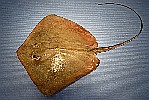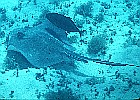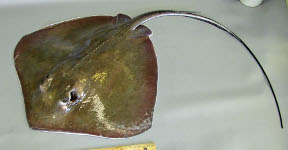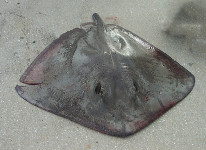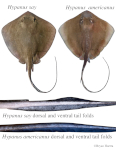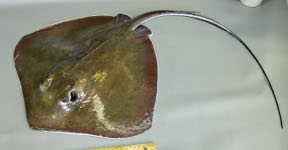Hypanus americanus
(Hildebrand & Schroeder, 1928)
Southern stingray
Classification: Elasmobranchii Myliobatiformes Dasyatidae
Reference of the original description
Fishes of Chesapeake Bay. Bulletin of the United States Bureau of Fisheries, 43(1), 1–366
Fishes of Chesapeake Bay. Bulletin of the United States Bureau of Fisheries, 43(1), 1–366
Image of the original description
Image in copyright.
Image in copyright.
Synonyms / new combinations and misspellings
Dasyatis americana, Dasyatis cf. americana, Hypanus americana
Dasyatis americana, Dasyatis cf. americana, Hypanus americana
Description :
Citation: Hypanus americanus (Hildebrand & Schroeder, 1928): In: Database of modern sharks, rays and chimaeras, www.shark-references.com, World Wide Web electronic publication, Version 04/2024
Please send your images of "Hypanus americanus" to info@shark-references.com
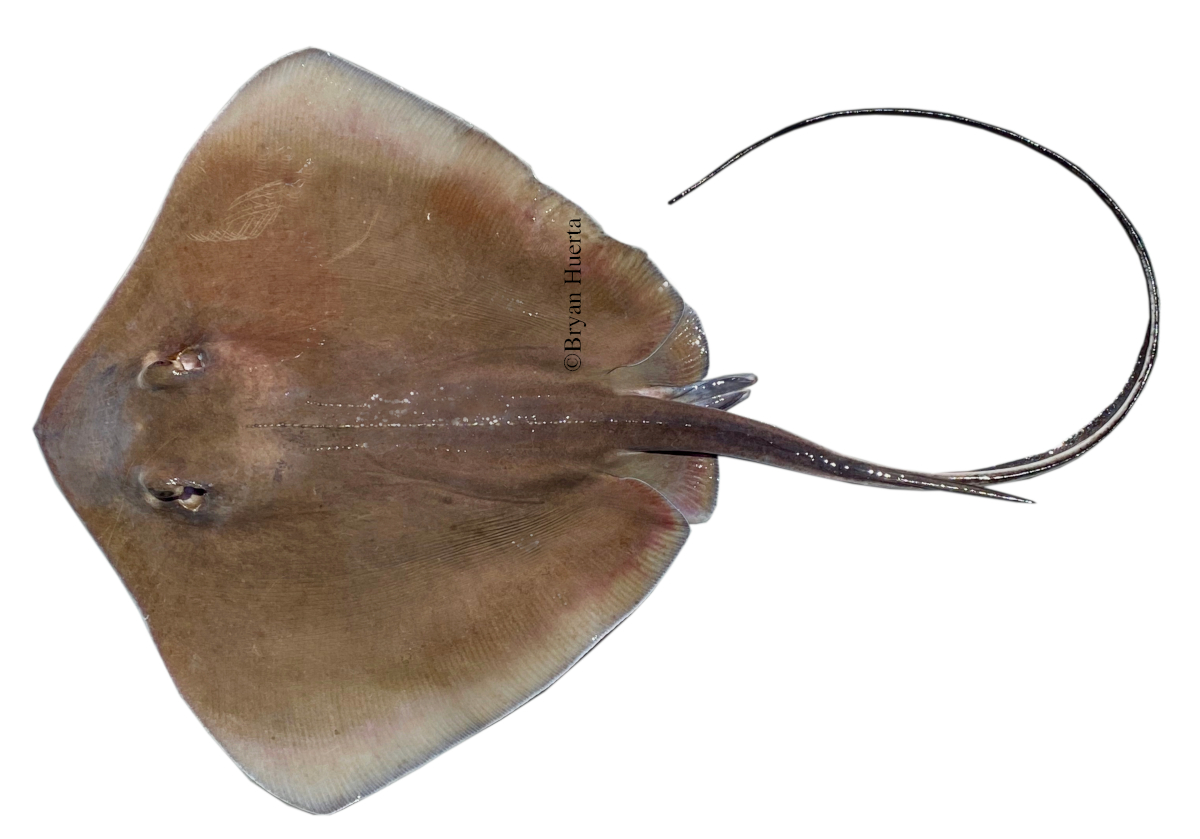
Hypanus americanus (Hildebrand & Schroeder, 1928), male, northern Gulf of Mexico © Bryan Huerta

Hypanus americanus (Hildebrand & Schroeder, 1928), male, northern Gulf of Mexico © Bryan Huerta
Common names
 Peitschenrochen,
Peitschenrochen,  Stechrochen,
Stechrochen,  Pastinaca,
Pastinaca,  Raya,
Raya,  Raya americana,
Raya americana,  Raya látigo,
Raya látigo,  Raya látigo blanca,
Raya látigo blanca,  Raya verde,
Raya verde,  Rayalatigo americana,
Rayalatigo americana,  Rayalátigo arrecifal,
Rayalátigo arrecifal,  Pastenague américaine,
Pastenague américaine,  Kit,
Kit,  Southern stingray,
Southern stingray,  Stingaree,
Stingaree,  Stingray,
Stingray,  Whip stingray,
Whip stingray,  Pastinaca,
Pastinaca,  Trigono,
Trigono,  Arraia,
Arraia,  Raia-cravadora,
Raia-cravadora,  Raia-lixa,
Raia-lixa,  Raia-prego
Raia-prego
 Peitschenrochen,
Peitschenrochen,  Stechrochen,
Stechrochen,  Pastinaca,
Pastinaca,  Raya,
Raya,  Raya americana,
Raya americana,  Raya látigo,
Raya látigo,  Raya látigo blanca,
Raya látigo blanca,  Raya verde,
Raya verde,  Rayalatigo americana,
Rayalatigo americana,  Rayalátigo arrecifal,
Rayalátigo arrecifal,  Pastenague américaine,
Pastenague américaine,  Kit,
Kit,  Southern stingray,
Southern stingray,  Stingaree,
Stingaree,  Stingray,
Stingray,  Whip stingray,
Whip stingray,  Pastinaca,
Pastinaca,  Trigono,
Trigono,  Arraia,
Arraia,  Raia-cravadora,
Raia-cravadora,  Raia-lixa,
Raia-lixa,  Raia-prego
Raia-prego
Short Description
Disk has sharp outer corners and irregular row of short spines on upper surface [17659]. Disk usually uniform dark brown above, grayer in young. Ventral finfold on tail long and high, dorsal finfold absent [17658]. Upper surface of disc gray, dark or olivaceous brown or olive green. Lower surface of disc white or whitish with an edging of gray or brown [199].
Disk has sharp outer corners and irregular row of short spines on upper surface [17659]. Disk usually uniform dark brown above, grayer in young. Ventral finfold on tail long and high, dorsal finfold absent [17658]. Upper surface of disc gray, dark or olivaceous brown or olive green. Lower surface of disc white or whitish with an edging of gray or brown [199].
Distribution
Western Atlantic: New Jersey, USA and northern Gulf of Mexico to southern Brazil, including the Antilles (Ref. 3168). Source: www.gbif.org
Western Atlantic: New Jersey, USA and northern Gulf of Mexico to southern Brazil, including the Antilles (Ref. 3168). Source: www.gbif.org
Human uses
fisheries: commercial; gamefish: yes
fisheries: commercial; gamefish: yes
Biology
Exhibit ovoviparity (aplacental viviparity), with embryos feeding initially on yolk, then receiving additional nourishment from the mother by indirect absorption of uterine fluid enriched with mucus, fat or protein through specialised structures [733]. Distinct pairing with embrace [17086]. Male mounts on female dorsally [1658]. Found on sandy bottoms, seagrass beds, lagoons and the reef face [1658]. Common in bays and estuaries [17658]. Observed singly, in pairs and in aggregations [1658]. Buries in the sand during the day and forages at night, usually in seagrass beds [1658]. Feeds mainly on bivalves and worms and also takes shrimps, crabs and small fishes (Ref. 3168). Omnivore (Ref. 57616). Feeds by creating depressions in the sand to expose invertebrates and small fishes (Ref. 9710). Equipped with a well-developed serrated spine and capable of inflicting a painful laceration. Easily approached by divers (Ref. 9710).
Exhibit ovoviparity (aplacental viviparity), with embryos feeding initially on yolk, then receiving additional nourishment from the mother by indirect absorption of uterine fluid enriched with mucus, fat or protein through specialised structures [733]. Distinct pairing with embrace [17086]. Male mounts on female dorsally [1658]. Found on sandy bottoms, seagrass beds, lagoons and the reef face [1658]. Common in bays and estuaries [17658]. Observed singly, in pairs and in aggregations [1658]. Buries in the sand during the day and forages at night, usually in seagrass beds [1658]. Feeds mainly on bivalves and worms and also takes shrimps, crabs and small fishes (Ref. 3168). Omnivore (Ref. 57616). Feeds by creating depressions in the sand to expose invertebrates and small fishes (Ref. 9710). Equipped with a well-developed serrated spine and capable of inflicting a painful laceration. Easily approached by divers (Ref. 9710).
Size / Weight / Age
200 cm WD (male/unsexed; (Ref. 3168)); max. published weight: 135.6 kg (Ref. 40637)
200 cm WD (male/unsexed; (Ref. 3168)); max. published weight: 135.6 kg (Ref. 40637)
Habitat
reef-associated; brackish; marine; depth range 0 - 53 m [2445], usually ? - 4 m (Ref. 55205)
reef-associated; brackish; marine; depth range 0 - 53 m [2445], usually ? - 4 m (Ref. 55205)
Remarks
shark-references Species-ID=14624;
shark-references Species-ID=14624;
Parasites (arranged by Jürgen Pollerspöck)
Monogenea
Cestoda
Isopoda
Hirudinea
Monogenea
- Dendromonocotyle octodiscus Hargis, 1955 [23992] [9445] [21204] [23771] [26032]
- Heterocotyle americana Hargis, 1955 [9644]
- Listrocephalos corona (Hargis, 1955) [17148]
- Loimopapillosum dasyatis Hargis, 1955 [17148]
- Merizocotyle longicirrus (Hargis, 1955) Chisholm, Wheeler & Beverley-Burton, 1995 [12239]
- Merizocotyle retorta (Hargis, 1955) Chisholm, Wheeler & Beverley-Burton, 1995 [17148] [17002] [12239]
- Monocotyle diademalis Hargis, 1955 [17205]
- Monocotyle pricei Pearse, 1949 [17104] [17205] [17001]
Cestoda
- Acanthobothrium americanum Campbell, 1969 [16177] [16356] [25154] [28741]
- Acanthobothrium brevissime Linton, 1908 [28741]
- Acanthobothrium lineatum Campbell, 1969 [28741]
- Acanthobothrium paulum Linton, 1890 [28741]
- Anthocephalum alicae Ruhnke, 1994 [16388]
- Anthocephalum cairae Ruhnke, 1994 [16388]
- Anthocephalum centrurum (Southwell, 1925) [16356]
- Anthocephalum gracile (Wedl, 1855) [25154]
- Anthocephalum kingae (Schmidt, 1978) Ruhnke & Seaman, 2009 [16266] [25154]
- Lecanicephalum peltatum Linton, 1890 [16265] [25154]
- Parachristianella monomegacantha Kruse, 1959 [16184] [16112]
- Polypocephalus medusia (Linton, 1890) [16265] [25154]
- Prochristianella hispida (Linton, 1890) [16184] [16112]
- Pterobothrium kingstoni Campbell & Beveridge, 1996 [16283] [16112]
- Pterobothrium lintoni (Maccallum, 1916) Dollfus, 1942 [16112]
- Rhinebothrium corymbum Campbell, 1975 [7620] [16356] [25154]
- Rhinebothrium lintoni Campbell, 1970 [16178]
- Rhinebothrium maccallumi Linton, 1924 [16178] [16908] [23771]
- Rhinebothrium margaritense Mayes & Brooks, 1981 [16356] [25154]
- Rhinebothrium spinicephalum Campbell, 1970 [16178]
- Rhodobothrium pulvinatum Linton, 1889 [16284] [16356] [25154]
- Scalithrium magniphallum (Brooks, 1977) Ball, Neifar & Euzet, 2003 [16266] [25154]
Isopoda
- Excorallana tricornis (Hansen, 1890) [23898] [19909]
- Rocinela signata Schioedte & Meinert, 1879 [19909]
Hirudinea








